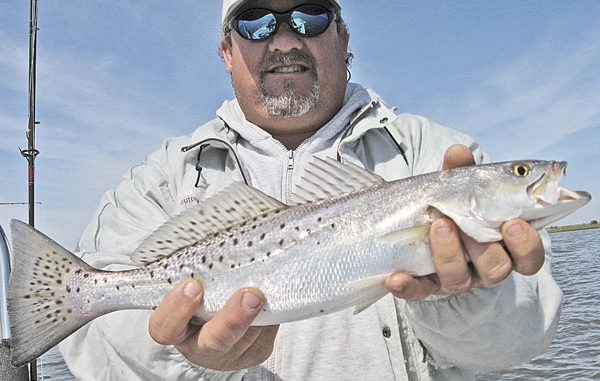
Ironically, it’s the fox squirrels — and not their smaller cousins — that draw hunters to Cat Island.
I spend a lot of time on the road tournament fishing, so when I’m home, I fish areas close to home like Delacroix and Venice.
October is a strange month for bass fishing because the water and the weather conditions at the beginning of the month often aren’t much different than the conditions in September.
But things change by the end of the month.
Generally from the middle to the end of October, if a cool front comes through, the buzz bait bite can be good all day. But if the region gets a high, sunny day and some wind, I’ll transition from the buzz bait to the spinnerbait. Also, at this time of year, the shad have started moving up on the flats, and you can have a great day fishing a lipless crankbait like the Strike King Red Eye Shad.
During October, the bass eventually begin to behave the same way they do in March during the pre-spawn. They become extremely active, chase bait and want to feed up heavily for the winter.
Buzz baits
Most of the time, I’ll be fishing a 1/2-ounce white or black buzz bait. If the water has a green tint, I may choose white/chartreuse, but primarily I’ll be fishing black or white. With this size buzz bait, I can reel it fast or slow, and throw it much farther than a smaller bait. On dark days, I’ll be fishing black, and on bright days, I’ll be fishing white. But when the water temperature drops below 65 degrees, the bass will take a black bait, regardless of whether the sky is dark or light.
Most anglers don’t consider buzz baits as hot- and cold-weather baits. Here in Louisiana, bass will crush topwaters when the water temperature is 55 degrees or colder. I’ve learned that the bass I catch on the buzz bait, especially in colder weather, generally will weigh 3 pounds or more.
Spinnerbaits
When I change to using the spinnerbait, I’ll be fishing a 1/2-ounce Strike King Premier Plus with willowleaf blades. This spinnerbait is the most-versatile one on the market. I can fish it just under the surface or slow-roll it across the bottom, and fish all the depths in-between.
I’m very particular about the color of spinnerbait I fish in September. I really like the golden shiner, the green gizzard shad, the smokey shad and the sun perch colors.
I only will fish the sun perch-colored spinnerbait in gin-clear water when I know the bass are feeding on perch and bluegills more than shad. During cloudy weather and in clear water, I prefer the golden shiner color. On sunny days and in clear water, I like the smokey shad. I like green gizzard shad for off-colored water.
The green gizzard shad and the smokey shad have nickel and gold blades. The golden shiner has two gold blades. Sometimes I’ll change the blade on the smokey shad, so I’ll have two nickel blades instead of a nickel and a gold blade.
Lipless crankbaits
At Delacroix and Venice, the bass really start feeding heavily on shad during October. Both Delacroix and Venice are blessed with not only saltwater but also freshwater baitfish. As the temperature drops, the baitfish move closer to the surface.
When fishing the flats, I prefer to fish either the chrome/blue or chrome/black 1/2-ounce Red Eye Shad on 20-pound-test Cajun fluorocarbon line with a 7-foot Quantum Energy PT rod and a 6.3:1 gear-ratio Quantum Energy PT reel. I don’t like the 7.0:1 Burner reel when I’m fishing lipless crankbaits because with that faster-retrieve reel, I tend to retrieve the crankbaits too fast.
Another reason I enjoy fishing Venice or Delacroix during October with the Red Eye Shad is because the speckled trout and redfish will be on those same flats with the bass. Back in August during one trip to Venice, I even caught some huge flounder on the Red Eye Shad. I’m a bass fisherman, so I’ll use bass-fishing techniques in salt water. I’ve found that these tactics are as productive on speckled trout, redfish and flounder as they are on bass.
For this reason, I can catch saltwater fish on bass lures while everyone else is fishing live bait. To catch the flounder, I’ll crank the Red Eye Shad just above the flounder, not using any stop-and-go-type action. I’ll just cast the bait out and reel it in. Most anglers believe you have to keep the bait close to the bottom to catch flounder. But I’ve seen flounder jump 2 feet out of the water when they blow up to eat baitfish close to the surface.
Remember, although flounder are bottom-oriented, their eyes sit on the tops of their heads. So the flounder are looking-up all the time. I’ve learned flounder will hit a lipless crankbait just like bass, speckled trout or redfish will. Recently, I caught two, 6-pound flounder on the Red Eye Shad.
I’m a tournament-bass fisherman, and I earn a living catching bass all over the country. But I’m also a Louisiana resident who likes to catch and eat fish. So when I’m fishing at Venice or Delacroix, if I catch a flounder, a speckled trout, a redfish or a small bass, I’ll release it into Lake Crisco.


